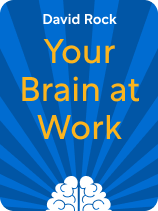

This article is an excerpt from the Shortform book guide to "Your Brain at Work" by David Rock. Shortform has the world's best summaries and analyses of books you should be reading.
Like this article? Sign up for a free trial here.
How does the brain interpret stressful situations at work? What can be done to mitigate these pressures?
Work environments can be stressful. Employees can feel threatened and unsure. By taking into consideration how the brain works, managers can take some of the pressure off. David Rock discusses two areas in particular: giving feedback in a low-stress way and establishing consistency.
Keep reading to learn how to reduce stress at work in these two practical ways.
Reducing Stress at Work
Your productivity can be impacted by the people around you. Most careers require some level of collaboration. However, coworkers, bosses, and clients can all have varying degrees of mental energy and emotional regulation themselves. While you can’t control the emotions and actions of others, you can understand which work situations trigger intense away emotions (and thus drain energy) as well as methods to mitigate these situations.
(Shortform note: Susan Cain argues in Quiet that too much collaboration can hurt productivity and that in fact, learning and creativity best happen in solitude. Studies show that with the increased opportunity for socialization that accompanied the rise of open-office designs came a rise in interruptions, social friction, and background noise—all of which deter productivity. Cain suggests an office space that provides areas to collaborate and areas to work alone.)
Before we look at how to reduce stress at work, let’s look at the brain science.
The Science
In the modern world, jobs are usually tied directly to our livelihoods. Therefore, when you feel as though your job is being threatened, your brain interprets these threats as a risk to your survival, similar to the way our primitive ancestors would have assessed the danger of a predator. When you’re in danger, adrenaline kicks your brain into a fight-or-flight response; in the workplace, this can translate into either avoidance or intense confrontation. Either reaction can harm productivity.
You feel the most threatened at work when you encounter change you weren’t prepared for. Your brain functions best when it’s at equilibrium, so any change—big or small—puts your brain into a state of dissonance, or disorder. It takes time and energy to regain your balance. If your brain doesn’t have an adequate amount of either, you’re more likely to respond with unchecked emotion.
For example, imagine that tomorrow is your annual review—the results of which determine your bonus for the year. You run into a coworker who reminds you that they sent you an email yesterday and makes a joke about how long you take to respond. Your brain probably didn’t anticipate this interaction, and most days, your brain may perceive it as friendly banter. However, with the stress of the upcoming review in which your job performance is evaluated, your brain could easily interpret the joke as a threat instead. This reaction could lead to lashing out at your coworker or being anxious during the review.
For leaders, it’s especially important to understand how unexpected change can cause threat responses in employees and diminish them when possible.
(Shortform note: Rock’s counsel to minimize threat responses at work is especially relevant to the Covid-19 pandemic—surveys show that work-related stress has amplified since the virus’s outbreak. The pandemic introduced unexpected changes into people’s work lives and intensified the strain of other stressors, such as anxiety over safety, job security, and work-life balance. Adequately preparing employees before making changes in these three areas may help reduce workers’ threat response.)
How to Use the Science
Rock points to two things that can upset the brain’s equilibrium, which leaders need to be particularly aware of: feedback and irregular procedures.
Measure #1: Give Feedback Wisely
Feedback is inherently stressful. Criticism usually comes from an authority figure who has the power to make changes in your life. Even if the criticism is intended to be constructive, an employee’s brain is going to immediately prepare the body for the threat of a major change.
Here are some ways Rock recommends that leaders reduce the stress of feedback:
- Regularly provide positive feedback.
- Consider public positive feedback.
- Normalize learning curves. One of the most significant pieces of feedback for an employee in a new position is reassurance that an adjustment period is normal.
- Focus “negative” feedback on the goal, not the employee’s weaknesses.
- Be transparent. When feedback results in corrective measures, Rock says you should explain your reasoning and make sure the other party understands the full context of a situation.
Measure #2: Establish Regular Procedures
To reduce potential threat responses in employees, Rock recommends that leaders stabilize as many aspects of a job as possible. The brain is in its comfort zone when it knows what to expect.
Here are some practices you can implement to establish consistency:
- Develop routines or templates for recurring tasks.
- Show your face in meetings. Facial expressions and body language help people understand what we’re communicating more fully. Misinterpretations can prompt threat responses.
- Share goals and accomplishments across departments. This information can help employees prepare for potential changes.
- Create spaces where people can share their personal lives. One of the ways to reduce uncertainty at work is for employees to have an idea of who they work with.

———End of Preview———
Like what you just read? Read the rest of the world's best book summary and analysis of David Rock's "Your Brain at Work" at Shortform.
Here's what you'll find in our full Your Brain at Work summary:
- How leaders can generate productive work environments
- How to schedule your day around your brain's energy levels
- Three steps to reactivate your creativity after a creative block






